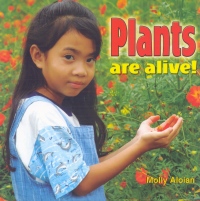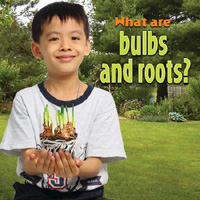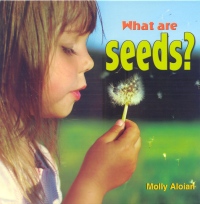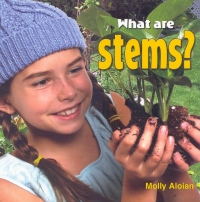| ________________
CM . . .
. Volume XIX Number 7. . . .October 19, 2012 
 |
Plants Are Alive! (Plants Close-Up).
Molly Aloian.
St. Catharines, ON: Crabtree, 2012.
24 pp., pbk. & hc., $7.95 (pbk.), $18.36 (RLB.).
ISBN 978-0-7787-4224-1 (pbk.), ISBN 978-0-7787-4219-7 (RLB).
Subject Headings:
Plants-Juvenile literature.
Plant anatomy-Juvenile literature.
Plant life cycles-Juvenile literature. Grades 1-3 / Ages 6-8.
Review by Barbara McMillan.
*** /4
|
| |
|
 |
What Are Bulbs and Roots? (Plants Close-Up).
Molly Aloian.
St. Catharines, ON: Crabtree, 2012.
24 pp., pbk. & hc., $7.95 (pbk.), $18.36 (RLB.).
ISBN 978-0-7787-4225-8 (pbk.), ISBN 978-0-7787-4220-3 (RLB).
Subject Headings:
Roots (Botany)-Juvenile literature.
Bulbs (Plant anatomy)-Juvenile literature.
Plant anatomy-Juvenile literature.
Grades 1-3 / Ages 6-8.
Review by Barbara McMillan.
*** /4
|
| |
|
 |
What Are Seeds? (Plants Close-Up).
Molly Aloian.
St. Catharines, ON: Crabtree, 2012.
24 pp., pbk. & hc., $7.95 (pbk.), $18.36 (RLB.).
ISBN 978-0-7787-4226-5 (pbk.), ISBN 978-0-7787-4221-0 (RLB).
Subject Headings:
Seeds-Juvenile literature.
Plant anatomy-Juvenile literature.
Grades 1-3 / Ages 6-8.
Review by Barbara McMillan.
*** /4
|
| |
|
 |
What Are Stems? (Plants Close-Up).
Molly Aloian.
St. Catharines, ON: Crabtree, 2012.
24 pp., pbk. & hc., $7.95 (pbk.), $18.36 (RLB.).
ISBN 978-0-7787-4227-2 (pbk.), ISBN 978-0-7787-4222-7 (RLB).
Subject Headings:
Stems (Botany)-Juvenile literature.
Plant anatomy-Juvenile literature.
Grades 1-3 / Ages 6-8.
Review by Barbara McMillan.
*** /4
|
| |
|

excerpt:
There are hundreds of thousands of different kinds of plants on Earth. All plants are alive. Plants are living things. (From Plants are Alive!)
So begins Molly Aloian's Plants are Alive!, the first of four-books in the "Plants Close-up" series published by Crabtree. In the 24 pages of the book, Aloian introduces young readers to the parts of plants, the functions of these parts, and to the life cycle of flowering plants. She does so by using two pages for each plant part and for each phase of a plant's life cycle. For example, when helping children to know about stems, she begins with the heading "The stem" and includes three sentences that inform children of the stem's importance in supporting the plant's leaves and flowers and in nourishing the leaves and flowers with water and nutrients carried up the stem from the plant's roots. The written information presented is reinforced with stock photographic illustrations of tulips growing out-of-doors and what appears to be a flowering impatiens plant in soil with its roots exposed. Such images cover from one-half to three-fourths of each page. The book ends with a half-page index of "Words to know" and the page numbers where words such as "flowers" and "seedling" can be found. The bottom half of the page is intended for parents and teachers. It includes an experiment and the titles of two books and two websites where more information on plants can be found. The experiment titled "What do plants need?" provides directions for testing the growth of bean plants from seeds using two manipulated variables and a control. All seeds are planted in cups with 2.5 cm of soil. The control is given sunlight and water, one test seed is given sunlight and no water, and a second test seed is given water and no sunlight. Children are to predict what they think will happen to each bean seed, to daily observe and record their observations and measurements, and to use their recorded data to draw conclusion about the needs of plants.
Aloian is also the author of What are Bulbs and Roots?, What are Stems?, and What are Seeds? in the "Plants Close-up" series. Although an identical format is used and similar information about plants as living things is included in the introduction to each book, redundancies in both the written text and the photographs used as illustrations are kept to a minimum. Young readers learn that it is possible for new plants to grow from bulbs, suckers, runners, and rhizomes, as well as seeds, and that some bulbs and roots are good to eat. When reading about stems, children are helped to know that the stems of cacti store water and nutrients, that potatoes are underground stems, and that stems with thorns protect plants from being eaten. There is also a section on nodes; the places where leaves, blower buds, and branches grow out of a stem, and the scars that are left on a stem when leaves falls off in the autumn. The book on seeds returns to the life cycle of a plant and focuses on the variety of seeds in nature, the main parts of a seed, mechanisms of seed dispersal, and seed germination. As with roots, bulbs, and stems, children also learn that some seeds, including the seeds of grains, are edible.
The suggested experiments in What are Bulbs and Roots?, What are Stems?, and What are Seeds? are quite common and will likely be familiar to, if not already used by, many teachers. They invite teachers and parents to encourage children to grow a new plant from a sweet potato or yam partially submerged in a jar of water, to examine the parts of a tulip bulb, to study what happens to a white carnation when the cut end of the flower's stem is placed in a jar with water and food colouring, to observe the seeds in a variety of fruits and vegetables, and to examine and identify the parts of a bean seed soaked in water.
Unfortunately, the two suggested websites listed in Plants are Alive! are the same two websites listed in all four books in the series. Moreover, the two suggested readings are the readings suggested in What are Seeds? and duplicate one of the two readings put forth in What are Stems? and What are Bulbs and Roots? As a result, all four books collectively list only three books where children can learn more about plants, and all three are published by Crabtree. That being said, the series is one that aligns with jurisdictions like Manitoba where the science cluster "Characteristics and Needs of Living Things" is taught in Grade 1 and the science cluster "Growth and Changes in Plants" is taught in Grade 3. I suggest that schools with library collections in need of books about plants at a Grade 1-2 reading level consider purchasing the "Plants Close-up" series or, if cost is a limiting factor, just Plants are Alive!.
Recommended.
Barbara McMillan is a teacher educator and a professor of science education in the Faculty of Education, the University of Manitoba, in Winnipeg, MB.

To comment
on this title or this review, send mail to cm@umanitoba.ca.
Copyright © the Manitoba Library Association. Reproduction for personal
use is permitted only if this copyright notice is maintained. Any
other reproduction is prohibited without permission.
NEXT REVIEW |
TABLE OF CONTENTS FOR THIS ISSUE
- October 19, 2012.
AUTHORS |
TITLES |
MEDIA REVIEWS |
PROFILES |
BACK ISSUES |
SEARCH |
CMARCHIVE |
HOME |



